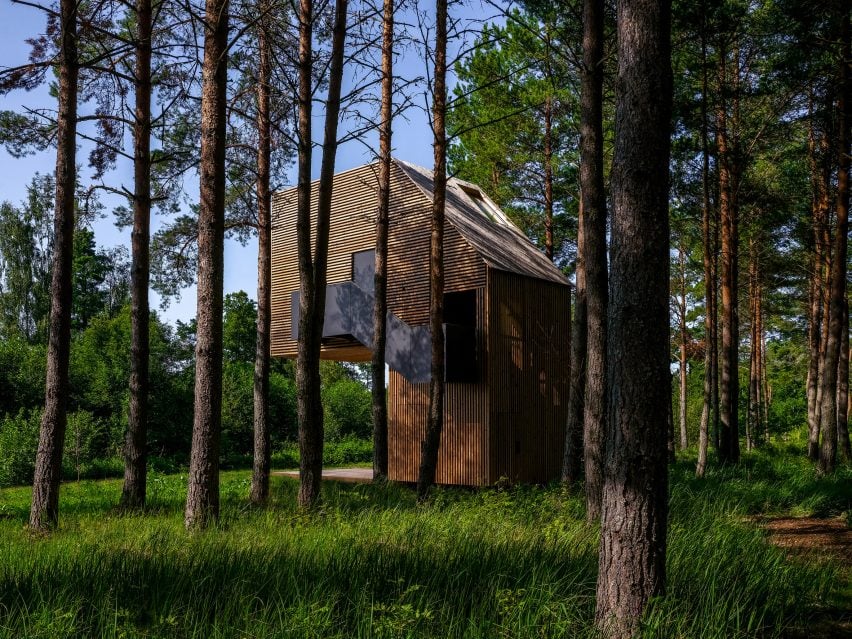Arsenit nestles one-legged "treehouse" in Estonian pine forest
Architecture studio Arsenit has designed Piil, a modular wood-and-steel holiday home elevated above the ground at the edge of a forest in Estonia.
The cantilevered house, which the studio describes as a treehouse, was made from steel and metal and was designed to balance on one leg above a wooden terrace.

It features a large cantilever that elevates the living spaces 4.25 metres above ground and creates a sheltered outdoor space.
Piil was informed by Estonia's observation towers, which are often placed in scenic locations, and assembled on-site.

"The architectural brief was for elevated accommodation — so at the start of the project four design options were explored, with only one involving a cantilever and the 'one-leg' approach, a sort of wild-card 'dream big' idea," Arsenit founder Arseni Timofejev told Dezeen.
"Further studies suggested this approach was not only feasible, but also had two key advantages: it reduced ground-level presence to a minimum, and allowed Piil to 'grow' taller by extending the 'leg' up by several levels — to elevate the accommodation further into the tree branches!"

The studio chose to construct the 19-square-metre building from a metal frame with timber cladding to create an organic feel alongside the nearby woodland.
"Using steel as the load-bearing truss-like-carcass minimised the building size – important for transporting modules – helped achieve a cantilevered structure, resulted in a system of modules for quick assembly on site, and could be done by the client, a metal manufacturer, in-house," Timofejev explained.
"At the same time, the aim of the project is to celebrate an escape into nature, so wood was a natural choice — that's why all the steel elements are painted black, to fade into the background and make the wood the main character."
Untreated, thermally modified pine by Estonian company Thermory was used for the exterior of the one-bedroom house.
"Over time, the pine cladding will weather gracefully to a silver-grey, helping the building blend in with its context," Timofejev said.

Inside, the building was "conceived as a large piece of joinery". Finished in white-washed oak, with vertical timber panelling to also reference treehouses, it has one main space with views out to the forest.
From the main sleeping area a staircase leads up to a mesh mezzanine that was designed as a space for Piil's visitors to relax and read with a view of the forest.

Piil, which was constructed off-site, was designed as a private retreat. It is the first of four similar buildings that are planned for the site, which will be rented out.
According to the architect, its modular design made it cheaper and safer to construct that traditional structures.

"The project is designed around the principle of modular pre-fabrication, with all the elements created off-site and quickly assembled in the scenic natural spot," Timofejev said.
"This approach results in a safer and more efficient working environment, reduces material waste, minimises cost and construction time."
Other recent projects in Estonia include a holiday home that references a surrounding forest and a cruise terminal building topped by a promenade.
The photography and video is by Yifan Liu.
Project credits:
Client and contractor: Levstal Group
Architect and lead designer: Arsenit
Structural engineers: SD Engineers, AVC Projekt OÜ
M&E consultants: AS Infragate Eesti, ICEkonsult OÜ, Pat-Pat Projekt OÜ
Joinery: ITB Interior OÜ